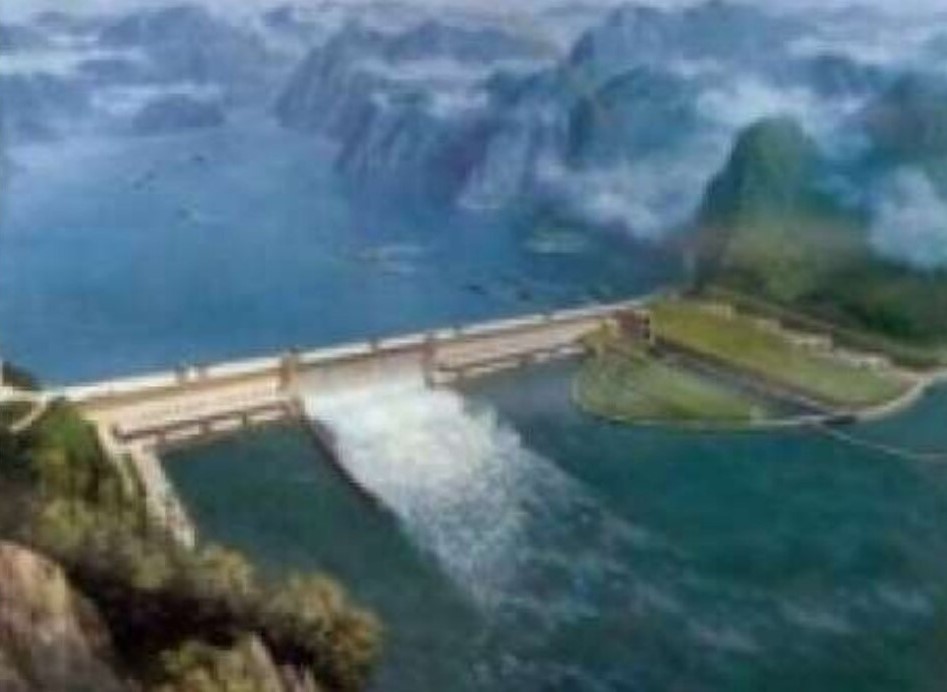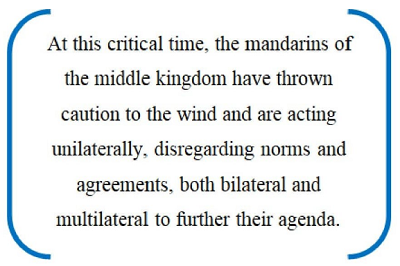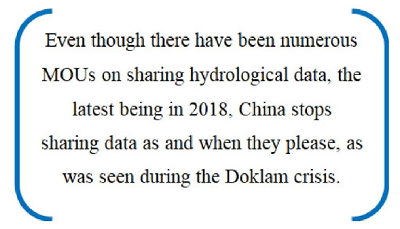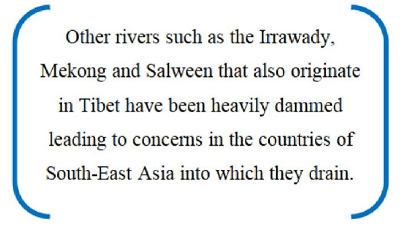Yash Johri, Research Intern, ICS
Shivi Sanyam, Advocate and former Judicial clerk, Supreme Court

Grave hostilities in Ladakh along the line of actual control (LAC) between India and China and actions on the part of government and business have dominated public discourse. External developments apart from those relating to Pakistan are rarely an issue in the domestic narrative but brewing anti-China sentiment amongst several parts of the populace has positioned our eastern neighbor in the national consciousness. While all eyes are fixated on the game of brinkmanship being played out on the LAC, it is an opportune moment to highlight another important area of contention: China’s management of Tibet’s rivers and the plausible impact on lower – riparian countries like India, this matter has arisen in the past and will certainly arise prominently, in the future.

We need to be better informed about this issue, therefore, it’s important to aggregate the cross-section of experience that exists on the issue from varying fields of business, government, law, climate studies, agriculture and others via analyses and interactions. As a student of China and Sino-Indian ties, one feels there are is a lack of dedicated efforts in the country to understand and prepare for the numerous complexities of our relationship with our eastern neighbor, especially with regard to the issue of management of the waters of Tibet. There is an urgent need to generate greater domain knowledge on this matter.
China in the present situation to deflect from the economic devastation that Covid – 19 has been inflicted on its economy and to divert the anger of its people with genuine grievances from the failures of the CCP, has kindled many of its rivalries. At this critical time, the mandarins of the middle kingdom have thrown caution to the wind and are acting unilaterally, disregarding norms and agreements, both bilateral and multilateral to further their agenda. There is a laundry list of enmities, many of these disputes are territorial and stem from China’s desire to maximize its economic and cultural influence.

It is in this political environment that there is a serious need for India to arouse consciousness nationally and build support at multilateral levels to put checks on China’s uninhibited dam building, water diverting and mining projects along the course of the Brahmaputra River (in China known as Yalung Zangbo). While the Chinese share hydrological data for the Sutlej and Brahmaputra, enabling us to anticipate water levels to prepare in time for flooding, they charge us a fee for that. It is interesting to note that, India does not charge its downstream neighbors- Pakistan and Bangladesh. Further, even though there have been numerous MOUs on sharing hydrological data, the latest being in 2018, they stop sharing data as and when they please, as was seen around the time of the Doklam crisis. There is little cooperation in addition to sharing hydrological data, while India has robust water sharing treaties with Pakistan and Bangladesh. It is estimated by Brahma Chellaney in his book, ‘Water: Asia’s New Battleground’ that until China has achieved its national objectives of power generation and river water diversion to its parched northern lands, it is unlikely to acquiesce to any agreement. India has on numerous occasions suffered from floods due to bursting of dams, polluted waters flowing into Arunachal due to upstream mining and construction activity and various other actions where the doctrine of ‘‘sic utere tuo ut alienum non laedas’’ (To use and exploit one’s sovereign property in such a manner so as to not harm the neighbor’s rights and interests) has not been followed.
China has a dual design on reigning in the Brahmaputra river with the future objective of not only generating power for the relatively underdeveloped region but also to divert waters of the Brahmaputra to their northern parts as the third phase of the South North Water Diversion Project (南水贝雕工程总体规划). The dam site they’ve chosen has been detailed by Chellaney in his book at Metog County, Nyingchi Prefecture, where they aspire to build a 38 GW(Gigawatts) generating facility (a capacity larger than the Three Gorges Dam), in comparison the Bhakra Nangal Dam generates a meagre 1.3 GW. Supporting infrastructure in the form of roads and railroads has already or are in the process of being constructed. This location near the Namche Barwa gorge is ideal for power generation given the steep natural fall that water takes before they enter India. Additionally, the point for the water diversion project is further upstream. This entire region is in the proximate area of Pemako, a region considered very sacred by Tibetan Buddhists – where there is vast virgin forests and varied flora and fauna. Further this region in particular is close to where the Indian and Eurasian plates converge thereby being prone to seismic risks.

It is now settled that China is the upper riparian power and reigns sovereign in these areas, following the NDA Government’s 2003 recognition of the Tibet Autonomous Region as a formal part of China. However, its exploitation of Tibet’s blue gold in the aforementioned megaproject and by way of numerous other projects such as the Zangmu dam (completed in 2014 with installed capacity of 500 MW), certainly affects the interests of lower riparian countries such as India and Bangladesh adversely. The NDA government’s action of course is only a cherry on top of the cake that was India’s concessionary foreign policy in the years post-independence. Other rivers such as the Irrawady, Mekong and Salween that also originate in Tibet have been heavily dammed leading to concerns in the countries of South-East Asia into which they drain. Given that many of China’s neighboring states have high dependency ratios (Food & Agriculture Organization data) relative to China for their water supply, with India (33.4%), Bangladesh (91.3% Including Ganga which originates in India), Laos (42.9%), Thailand (47.1%), Cambodia (74.7%) and Vietnam (58.9%), there is certainly a need for a mechanism to ensure a sustainable integrated river basin management. However, the Chinese style is to only deal bilaterally, if at all, as they have stayed away from any such multilateral arrangements, the Mekong River Commission being one of them. Further, China was one of three countries along with upper riparian Turkey that opposed the UN Convention on Non-Navigational use of International Watercourses in 1997, the resolution carried 103-3 with 27 abstentions.
Any questions pertaining to integrated basin management with China will in turn throw up our policy on Tibet, while as a rule – following country we must abide by past treaties and commitments but should certainly not leave any leverage we may have with regard to the land of the Dalai Lama of the table. The entire world is re-evaluating and taking a hard-look at their respective approaches to China, in the aftermath of the events in the Galwan valley, we must do the same.
The North-East of our country being a riverine civilization will feel the major brunt of China’s unilateral action in Tibet, which it refers to as its water tower. While the seven sisters are undoubtedly far away from New Delhi, and given our food surplus at the moment water security may seem like a distant concern. However if we are to act east, we must ensure our water security, not only for the purposes of agriculture, fisheries and the dependent communities but also to generate our own power.
Originally Published as The Great Sino-Indian Water Conundrum in The Guardian,15 July 2020.